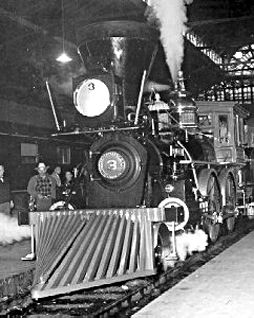L&N became major player in Civil War
with 250 miles of track in its system
With the outbreak of the Civil War, railroads were discovered to be a key means of transportation for men and materiel.
And, in Kentucky, which was a neutral state, rail transportation possibilities attracted the attention of both the Union and the Confederacy. Both sides could profit from transportation within the Commonwealth, a major link between north and south.
That’s where the Louisville and Nashville Railroad (L&N) came in.
The L&N suddenly became a major player.
 Its first line extended barely south of Louisville and it took until 1859 to span the 180-odd miles to its second namesake city of Nashville. There were about 250 miles (400 km) of track in the system by the outbreak of the Civil War and its strategic location, spanning the Union/Confederate lines, made it of great interest to both governments.
Its first line extended barely south of Louisville and it took until 1859 to span the 180-odd miles to its second namesake city of Nashville. There were about 250 miles (400 km) of track in the system by the outbreak of the Civil War and its strategic location, spanning the Union/Confederate lines, made it of great interest to both governments.
During the Civil War, different parts of the network were pressed into service by both armies at various times and considerable damage from wear, battle and sabotage occurred. However, the company benefited from being based in a Union state and the fact that Nashville fell to Union forces within the first year of the war and remained in their hands for its duration.
The L&N profited from Northern haulage contracts for troops and supplies, paid in sound Federal “greenbacks,” as opposed to the rapidly-depreciating Confederate dollars. After the war, it found that its Southern competitors were devastated to the point of collapse and the general economic depression meant that labor and materials to repair its roads could be had fairly cheaply.
Buoyed by these fortunate circumstances, the firm began an expansion that never really stopped. Within 30 years, the network reached from Ohio and Missouri to Louisiana and Florida.
By 1884, the firm had such importance that it was included in the Dow Jones Transportation Average, the first American stock market index.
It was so active a customer of the Rogers Locomotive and Machine Works, the country’s second largest locomotive maker, that in 1879 the firm presented L&N with a free locomotive as a thank-you bonus.
Under Milton H. Smith, president of the company for 30 years, the L&N grew from a road with less than 300 miles of track to a 6,000-mile system serving 13 states. As one of the premier Southern railroads, the L&N extended its reach far beyond its namesake cities, stretching to St. Louis, Memphis, Atlanta and New Orleans. The railroad was economically strong throughout its lifetime, operating both freight and passenger trains in a manner that earned it the nickname, “The Old Reliable.”
Although the L&N had a great Kentucky reputation, it
was another native of  the Commonwealth who also made
the Commonwealth who also made
Civil War railroad history.
On April 12, 1862, a group composed of civilians and Union soldiers embarked on a daring feat with the primary goal of disrupting the vital link between Atlanta and Chattanooga. A civilian scout and part-time spy, Flemingsburg native James J. Andrews, led a band of 20 men upon a hijacked steam locomotive, “The General,” with plans to burn bridges, pull up rails and “if successful, change the whole aspect of the war, and aid materially in bringing an early peace to our distracted country.”
Pursuit of Andrew’s Raiders and the General happened immediately on foot, by hand car and by train, but the chase literally ran out of steam after an exciting 87 miles. Only eight of the 20 men (Andrews among them) were tried as spies and executed in Atlanta. The rest either escaped or were exchanged. Nevertheless, the train thieves were hailed in the North as heroes.
“The General” finally made it to Louisville and the L&N in
1962, providing Kentuckians the opportunity to view a lead
player in a Civil War saga. The L&N rebuilt the locomotive in
’62, converting it to burn oil and ran it on short trips on the
company line.
Ready to go
“The General” stands ready for another trip at Louisville & Nashville Railroad’s Union Station in 1962.
L&N rebuilt “The General” after many years of display at Chattanooga Union Station.
The engine gained fame for its participation in the “Great Locomotive Chase” during the Civil War.







